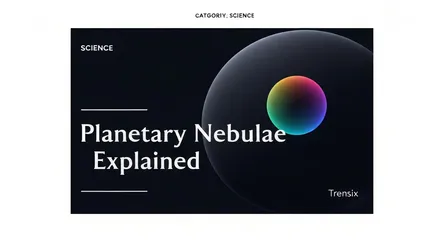Science
Planetary Nebulae Explained

Explore planetary nebulae, the stunning, glowing shells of gas expelled by dying stars. Learn how these cosmic ghosts form and what they teach us.
What is it?
A planetary nebula, despite its name, has nothing to do with planets. It is an awe-inspiring celestial object consisting of an expanding, glowing shell of ionized gas ejected from a sun-like star in its final stages of life. As the star exhausts its nuclear fuel, its outer layers drift off into space. The hot, dense core left behind, known as a white dwarf, illuminates this surrounding gas, causing it to fluoresce in vibrant colors. These nebulae are relatively short-lived cosmic phenomena, lasting only a few tens of thousands of years before the gas disperses into the interstellar medium.
Why is it trending?
Planetary nebulae are trending thanks to advanced telescopes like the James Webb Space Telescope (JWST). These powerful observatories are capturing images of unprecedented detail, revealing intricate structures like jets, knots, and complex symmetries that challenge existing theories of stellar evolution. Astronomers are studying their chemical composition to understand how stars synthesize and distribute heavy elements, such as carbon and nitrogen, throughout the galaxy. Each new image provides a deeper look into the dramatic death throes of stars.
How does it affect people?
Studying planetary nebulae offers a glimpse into the future of our own solar system, as our Sun is expected to form one in about five billion years. They are cosmic recycling plants, enriching the interstellar medium with heavy elements that are essential for the formation of new stars, planets, and potentially life. On a more immediate level, their breathtaking beauty inspires public interest in science and astronomy, reminding us of the vastness and wonder of the universe and our place within it.